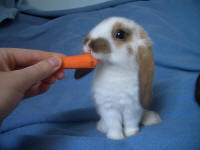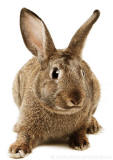|
|
What exactly is behavior modification? To put it simply, behavior modification does just that, modifies behavior. We can modify the behavior of our Pets by using different types of behavior modification techniques.
Types of Behavior Modification Techniques
Classical conditioning - the pairing of two stimuli which would normally have no relation to mean something when combined. A rabbit who sees a child for the first time is offered a treat from this child. The two unrelated stimuli are the child and the treat. The next time the rabbit sees a child he automatically gets excited and recalls the positive experience from the first child and eagerly wants to say "Hello!" in hopes of another treat.
Counter conditioning - changing a Pet's emotional response, feelings, or attitude, to some type of stimulus. An example of this would be to change the way a rabbit feels about going into the bathtub by helping them to perceive it as a happy, wonderful place to be rather than a feared object. This is accomplished through positive reinforcement such as feeding high value treats or providing favorite toys. Counter conditioning is typically used in conjunction with desensitization which is gradual exposure to stimulus that is not accepted by a Pet at a low enough level to not cause any negative response.
Flooding - a technique used to modify fearful behavior is to continuously expose a Pet to their fear until it settles down. When the Pet calms down reinforcement is given to create a positive association with the stimulus. Once a Pet is exposed to the stimulus, the stimulus cannot be removed until the Pet calms down. Under no circumstances is the Pet parent allowed to intervene or punish the Pet while flooding as this would lead to a negative association to the stimulus. Since exposure must continue until the Pet has settled down, it is most successfully used with fears that are not intense. It is not recommended in cases where a Pet is likely to panic when exposed to the stimulus. Keeping your Pet in a cage or kennel or on a leash or halter during exposure will prevent escape and prevent injury. During exposure we ignore any tense behavior or whining. When bunny settles down give lots of praise and treats.
Operant conditioning - the way behavior is shaped by positive and negative consequences. Operant conditioning includes positive punishment and reinforcement along with negative punishment and reinforcement.
What is the difference between positive and negative reinforcement?
 Positive reinforcement means we are ADDING something GOOD to increase or reinforce the chance that a behavior will occur. For example, we offer a treat when training our rabbit to do a trick. This would be considered positive reinforcement. Positive reinforcement means we are ADDING something GOOD to increase or reinforce the chance that a behavior will occur. For example, we offer a treat when training our rabbit to do a trick. This would be considered positive reinforcement.
Negative reinforcement means we are REMOVING something BAD to increase or reinforce the chance that a behavior will occur.
What does this mean to Pet Parents?
Positive reinforcement is much more likely to produce the results you are looking for. In general, it is accepted that negative reinforcement can contribute to fearful and aggressive Pets.
Two very different scenarios using Positive vs Negative Reinforcement
Scenario #1 - Thumper runs out the door across
the fenced backyard. Pet parent
angrily calls Thumper to him,
Thumper returns, Pet parent swats
Thumper on the behind for running out the door and takes him back inside.
Scenario #2 - Thumper runs out the door across the fenced backyard. Pet parent excitedly calls
Thumper to him, Thumper returns, Pet parent makes a big fuss over what a good
bunny Thumper is for returning and offers a treat.
In which scenario do you think Thumper is most likely to come to their Pet parent the next time
Thumper goes outside?
Positive Vs. Negative Punishment
Now this is where things start to get fun! With all these positives and negatives, it's easy to become confused! But that's okay because we're going to make this simple to understand.
Positive punishment is ADDING something BAD to decrease or punish a behavior. An example of this would be squirting your bunny for chewing something inappropriate.
Negative punishment is REMOVING something GOOD to decrease or punish a behavior. An example of this would be removing your attention or ignoring your rabbit when they are incessantly begging for a treat.
See if you can tell which scenario is positive punishment and which is negative punishment?
Scenario #1 - Thumper is bouncing around and thumping because he is irritated about being ignored, owner picks up spray bottle and squirts Thumper for bouncing and thumping.
Scenario #2 - Thumper is bouncing around and thumping because he is irritated about being ignored, owner waits until the bouncing and squealing stops, once behavior has stopped, owner picks up Thumper and gives a treat for stopping the bouncing and thumping.
Did you guess correctly? Scenario #1 is positive punishment and scenario # 2 is negative punishment. Which method do you think will work in the long term? The negative punishment method (#2) will work better because it does not cause Thumper to be fearful or distrustful of his Pet parent.
Species-Specific Behavior
 These are behaviors or characteristics common to all members of a species.
For example, cats scratch with their claws to stretch their tendons and muscles, to remove the dead sheaths, and to mark their territory. These are behaviors or characteristics common to all members of a species.
For example, cats scratch with their claws to stretch their tendons and muscles, to remove the dead sheaths, and to mark their territory.
Dogs have specific vocalizations for communication, such as barking, whining, howling or growling. Rabbits thump and guinea pigs make many unique vocalizations; these are all species-specific behaviors. Species-specific behaviors can be altered by captivity, training, or a change of environment.
Predator Vs. Prey Pet Mentality
Predators hunt and eat other animals, which results in the development of certain behaviors. They use their senses of sight and hearing and they lay in wait, stalk, strike, and pounce. Prey animals typically eat things other than other animals, so they develop survival skills instead of hunting skills.
If species-specific behavior, predator vs. prey mentality, and principles of learning are understood and applied in the management of our Pets, behavior problems can be prevented and treated.
|